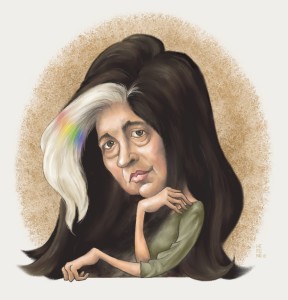 As Consciousness Is Harnessed to Flesh:
As Consciousness Is Harnessed to Flesh:
Journals and Notebooks, 1964-1980
by Susan Sontag
Edited by David Rieff
Farrar, Straus and Giroux
523 pages, $30.
EVER SINCE reviewing Reborn, the first volume of Susan Sontag’s journals and notebooks, in these pages (May-June, 2009), I’ve been eager to read the next installment of her observations about the world. The three-volume series is being edited by Sontag’s son, David Rieff, who describes this volume as “a political bildungsroman … in the sense of a person’s education, her coming to maturity.”
This volume covers Sontag’s life from age 31 to 47. During this period, she wrote some of her best-known essays, including the epic “Notes on Camp” (1964).
Rieff comments that his mother “tended to write more in her journals when she was unhappy, most when she was bitterly unhappy, and least when she was all right.” If we follow this formula, then we have to conclude that Sontag’s long passages about her love affairs with Nicole, Irene, Carlotta, Harriet, and Eva are emblematic of a terribly unhappy love life, and this conclusion would not be wrong.
Many of her entries detail and analyze her troubled relationship with her mother and longing for her father, who died when she was four. She reveals conflicted feelings about her body, doubts about herself as a lover, anxieties around her sexuality and femininity, and concerns over whether she’s a good mother. In one of the few self-affirming statements, she writes (Dec ember 23, 1973): “But I was saved for sexuality—at least partially—by women. … How grateful I am to women—who gave me a body.”
ember 23, 1973): “But I was saved for sexuality—at least partially—by women. … How grateful I am to women—who gave me a body.”
Sontag was a list maker: pages and pages of her journals are filled with lists of books to read, movies to see, and music to listen to. She also writes about possible essays, plays, and books that she wants to write. She tells us what she likes: “urinating, pizza, the color blue, making lists, asking questions.” And what she doesn’t like: “television, paperback books, alcoholics … taking photographs.” (Yet she did write an entire book of essays in 1977, On Photography).
From 1974 to 1977, Sontag underwent treatment for breast cancer. There is little mention of this experience in her journals. She makes two brief entries that touch on her anxieties in the face of illness. On November 5, 1976, she writes: “trying to race ahead of my death.” We learn of her struggles to make sense of her life and work (August 9, 1967): “Feeling of discontinuity as a person. My various selves—woman, mother, teacher, lover, etc.—how do they all come together?” She defined her role as “the intellectual as adversary. (So now, must I be adversary to myself?)” (March 17, 1975). She later explains (Sept 4, 1975): “I am an adversary writer. … I write to support what is attacked, to attack what is acclaimed.”
As brilliant as it is, this book is also frustrating in some ways. The entries are arranged chronologically with no other markers, and there’s no index. In order to find anything in terms of themes, topics, places, and persons, the reader has to plow through the entire book. There’s also the problem of Rieff acting as his mother’s editor. As her only and much beloved son, Rieff is in a position that calls into question his ability to be dispassionate in the presentation of his mother’s journals and notebooks. One wonders where Rieff’s contribution ends and Sontag’s begins.
Despite these challenges, the journals themselves are mesmerizing. Sontag emerges as an all-too-human figure who suffers from terrible loneliness. The person behind the persona is revealed to be someone who suffers from fears of abandonment. She writes (May 25, 1975): “I have more and more difficulty being alone, even for a few hours.” Her struggles with various demons are frequently mingled with her need to express herself creatively (February 17, 1970): “I see life as a set of projects / tasks.”
The book’s title comes from a sentence Sontag wrote in the margin of an entry made on May 22, 1965. “A spiritual project—but tied to making an object (as consciousness is harnessed to flesh).” Sontag’s life work involved concretizing ideas in her writing. She challenged herself to materialize and embody her feelings and thoughts in her creative output. “Consciousness … harnessed to flesh” sums up this literary project—and is itself an example of it.
Irene Javors, a psychotherapist based in New York, teaches in the Graduate School of Psychology at Yeshiva University. She is the author of Culture Notes: Essays on Sane Living.





